CHEVROLET CAVALIER 1994 1.G Owners Manual
Manufacturer: CHEVROLET, Model Year: 1994, Model line: CAVALIER, Model: CHEVROLET CAVALIER 1994 1.GPages: 243, PDF Size: 15.06 MB
Page 141 of 243
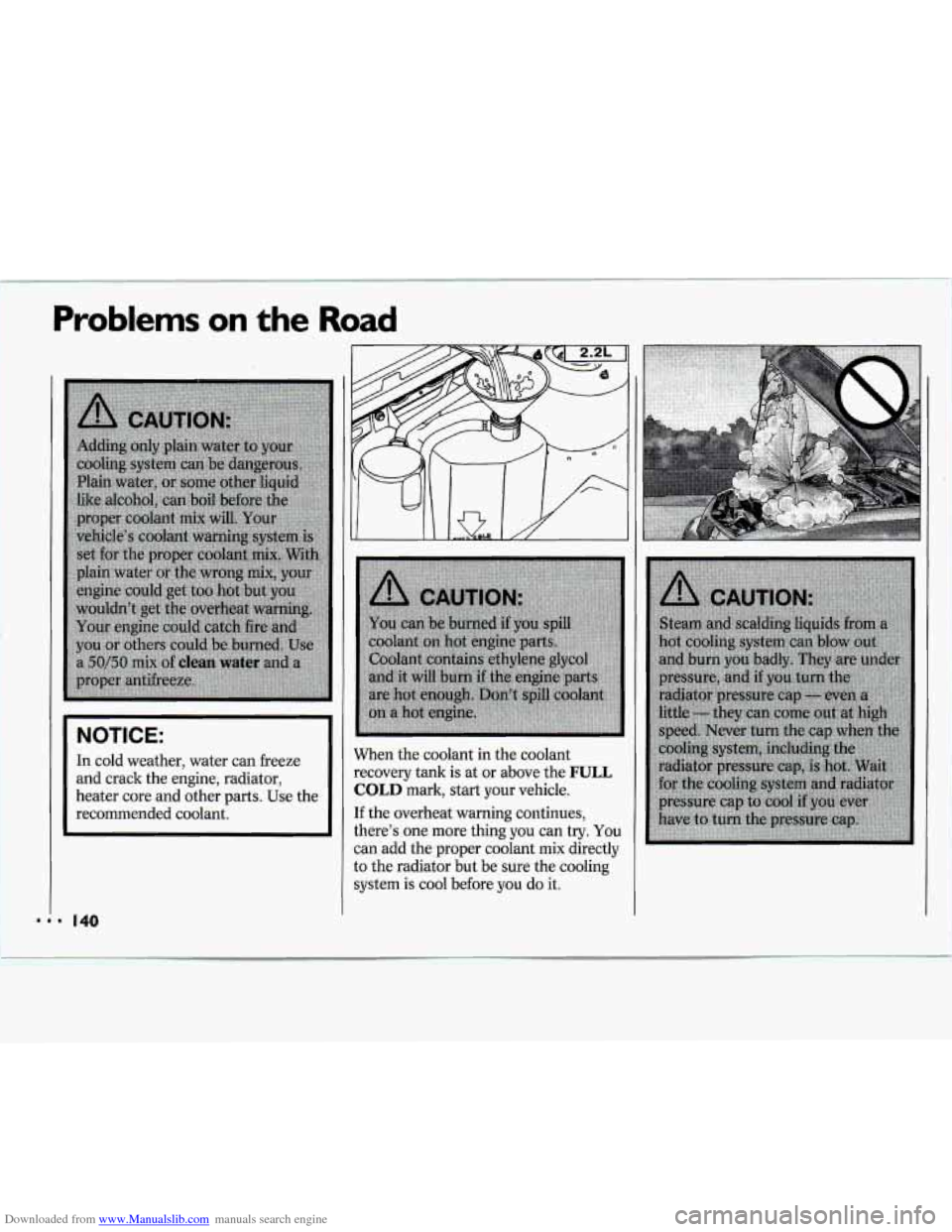
Downloaded from www.Manualslib.com manuals search engine Problems on the Road
I NOTICE: I
In cold weather, water can freeze
and crack the engine, radiator,
heater core and other parts. Use the
recommended coolant. When
the coolant in the coolant
recovery tank is at or above the FULL
COLD mark, start your vehicle.
If the overheat warning continues,
there's one more thing you can try.
You
can add the proper coolant mix directly
to the radiator but be sure the cooling
system
is cool before you do it.
Page 142 of 243
![CHEVROLET CAVALIER 1994 1.G Owners Manual Downloaded from www.Manualslib.com manuals search engine I
I 2.2L ]
How to Add Coolant to the 2.21
14 Engne at the Radiator
1. You can remove the radiator pressure
cap when the cooling sys CHEVROLET CAVALIER 1994 1.G Owners Manual Downloaded from www.Manualslib.com manuals search engine I
I 2.2L ]
How to Add Coolant to the 2.21
14 Engne at the Radiator
1. You can remove the radiator pressure
cap when the cooling sys](/img/24/8078/w960_8078-141.png)
Downloaded from www.Manualslib.com manuals search engine I
I 2.2L ]
How to Add Coolant to the 2.21
14 Engne at the Radiator
1. You can remove the radiator pressure
cap when the cooling system,
including the radiator pressure cap
and upper radiator hose, is no longer
hot. Turn the pressure cap slowly to
the left until
it first stops. (Don’t
press down while turning the
pressure cap.) If you hear a hiss, wait
for that to stop. A hiss means there is
still some pressure left.
I 2.2L
n
2. Then keep turning the pressure cap,
but now push down as you turn it.
Remove the pressure cap. 3. Fill the radiator with the proper mix,
up to the base of the filler neck.
Page 143 of 243
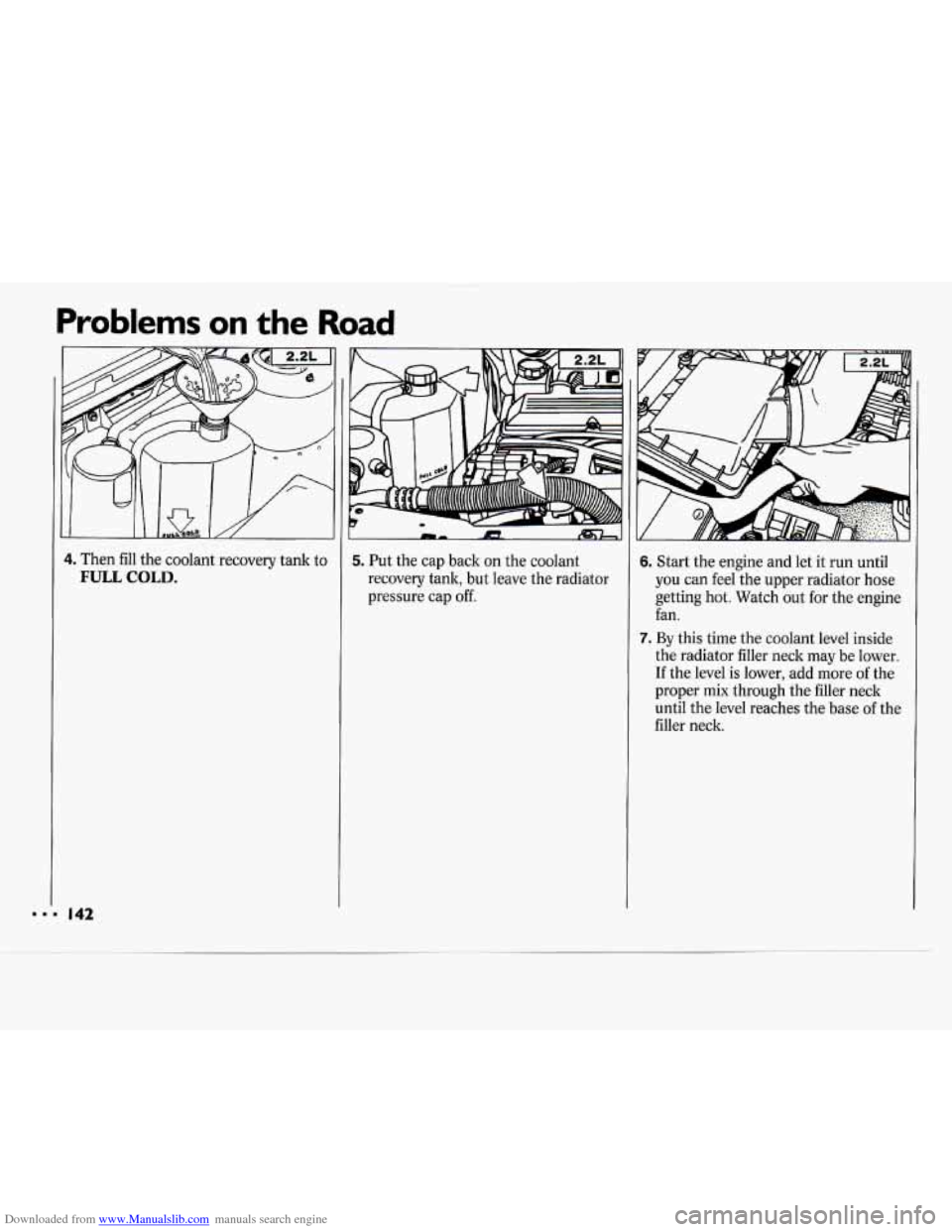
Downloaded from www.Manualslib.com manuals search engine Problems on the Road
4. Then fill the coolant recovery tank to
FULL COLD.
I
m.4 142
II- m
5. Put the cap back on the coolant
recovery tank, but leave the radiator
pressure cap off. 6. Start the engine and let it run until
you can feel the upper radiator hose
getting hot. Watch out for the engine
fan.
7. By this time the coolant level inside
the radiator filler neck may be lower.
If the level is lower, add more
of the
proper
mix through the filler neck
until the level reaches the base of the
filler neck.
Page 144 of 243
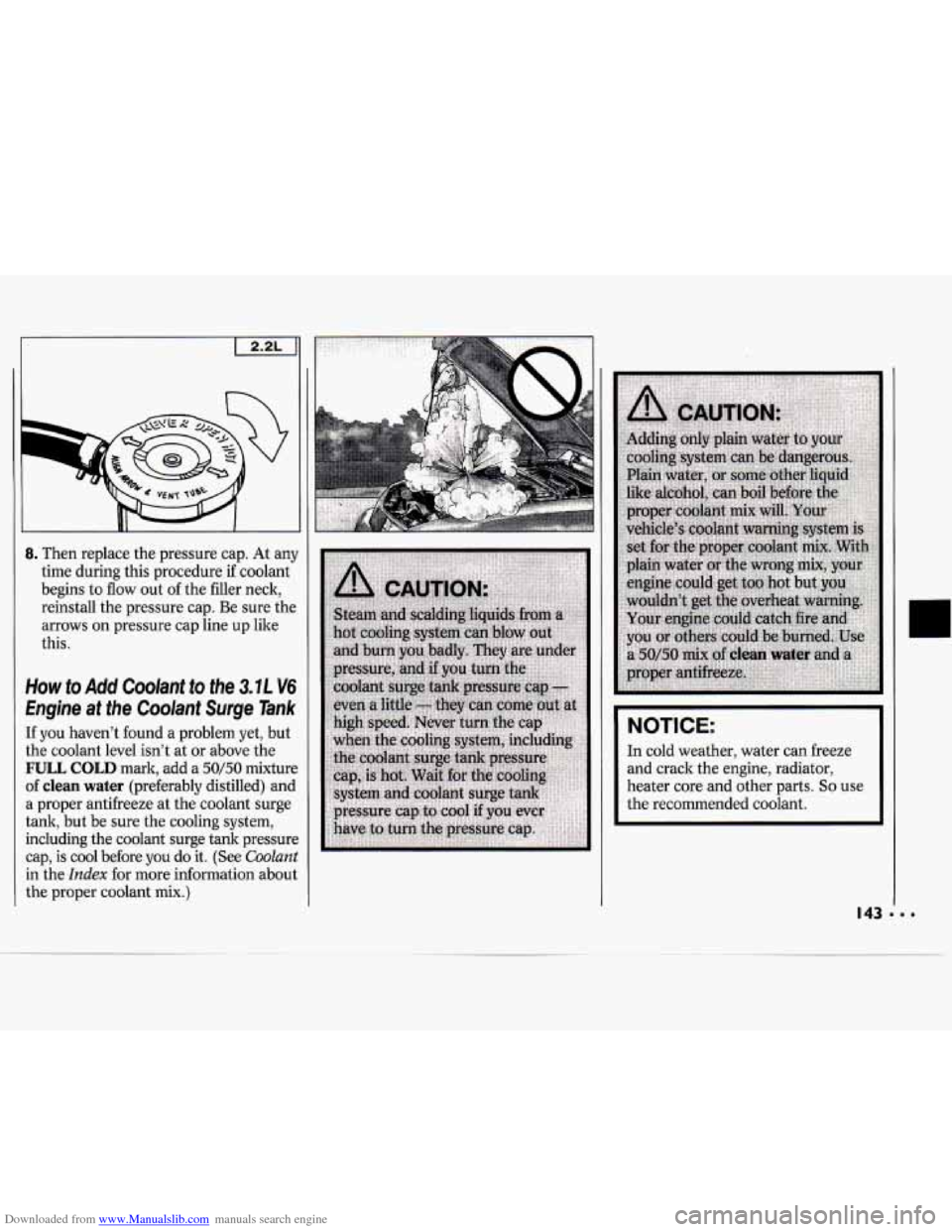
Downloaded from www.Manualslib.com manuals search engine II
R
8. Then replace the pressure cap. At anj
time during this procedure
if coolant
begins to flow
out of the filler neck,
reinstall the pressure cap. Be sure the
arrows
on pressure cap line up like
this.
How to Add Coolant to the 3.7L V6
€ngine at the Coolant Surge Tank
If you haven't found a problem yet, but
the coolant level isn't at or above the
FULL COLD mark, add a 50/50 mixture
of clean water (preferably distilled) and
a proper antifreeze at the coolant surge
tank, but be sure the cooling system,
including the coolant surge tank pressure
cap,
is cool before you do it. (See CooZuni
in the Index for more information about
the proper coolant mix.)
NOTICE:
In cold weather, water can freeze
and crack the engine, radiator,
heater core and other parts.
So use
the recommended coolant.
Page 145 of 243
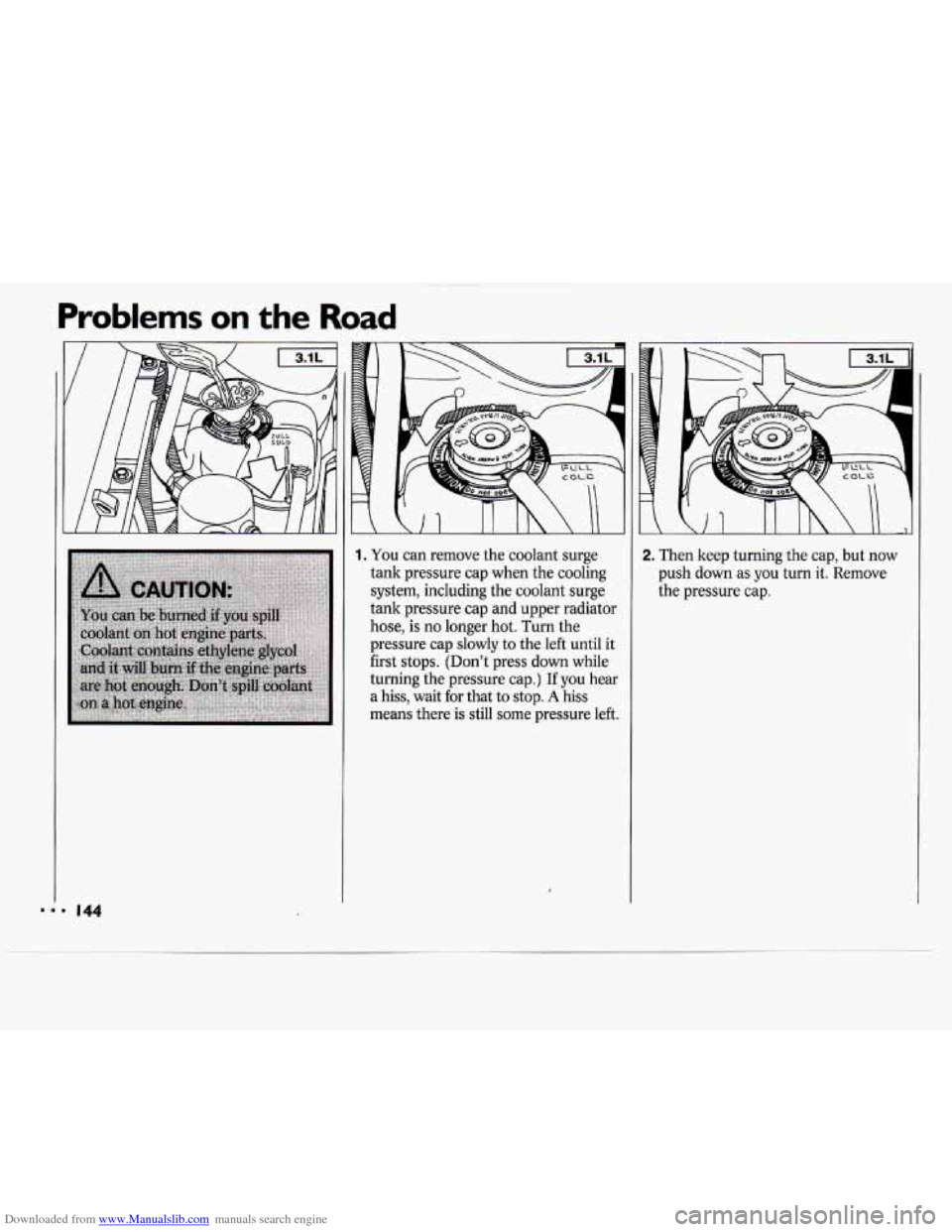
Downloaded from www.Manualslib.com manuals search engine Problems on the Road
1. You can remove the coolant surge
tank pressure cap when the cooling
system, including the coolant surge
tank pressure cap and upper radiator
hose, is no longer hot. Turn the
pressure
cap slowly to the left until it
first stops. (Don't press down while
turning the pressure cap.)
If you hear
a hiss, wait for that to stop.
A hiss
means there is still some pressure left.
2. Then keep turning the cap, but now
push down as you turn it. Remove
the pressure cap.
Page 146 of 243
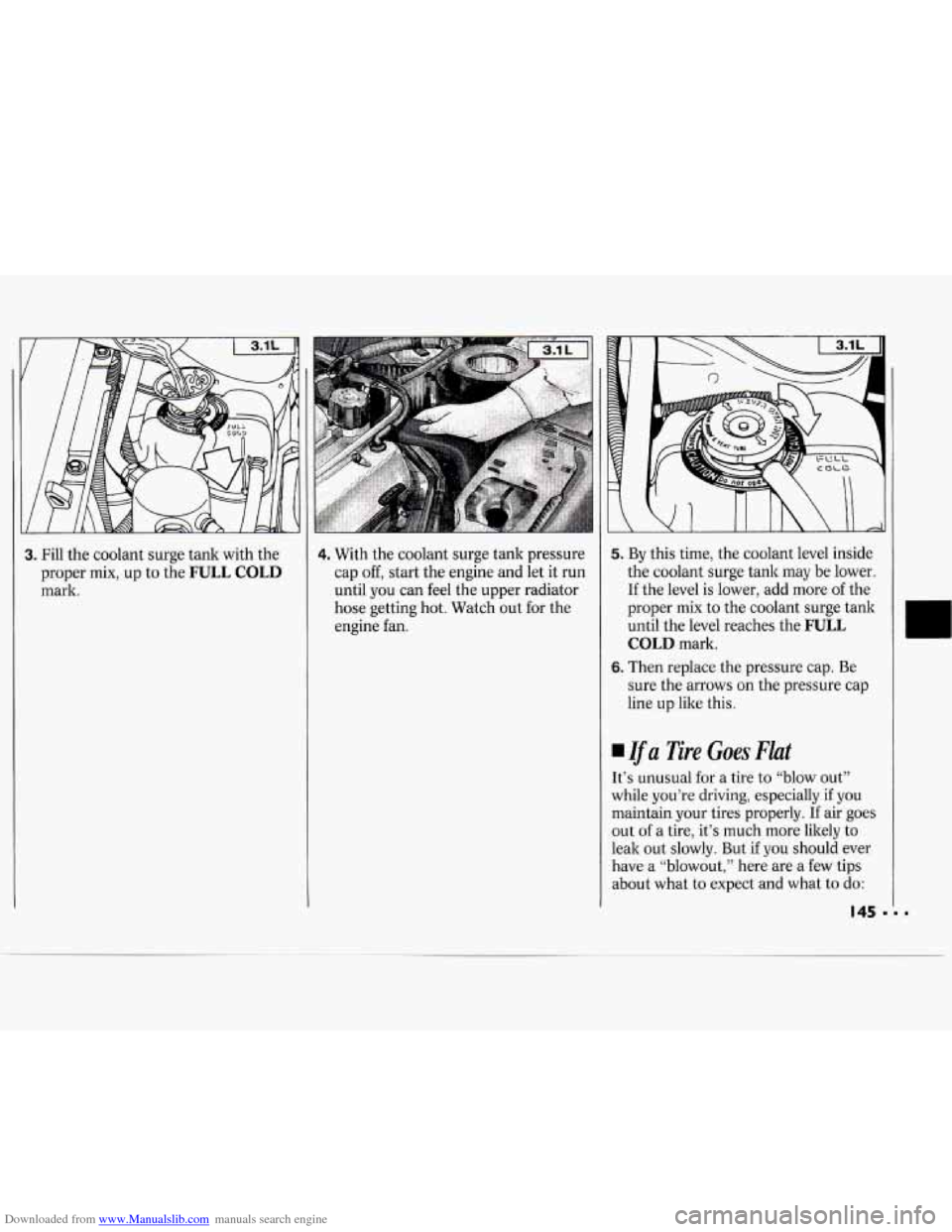
Downloaded from www.Manualslib.com manuals search engine 3. Fill the coolant surge tank with the
proper mix, up to the
FULL COLD
mark.
4. With the coolant surge tank pressure
cap
off, start the engine and let it run
until you can feel the upper radiator
hose getting hot. Watch out for the
engine fan.
5. By this time, the coolant level inside
the coolant surge tank may be lower.
If the level is lower, add more of the
proper mix to the coolant surge tank
until the level reaches the
FULL
COLD mark.
6. Then replace the pressure cap. Be
sure the arrows
on the pressure cap
line up like this.
Ifa Tire Goes Flat
It’s unusual for a tire to “blow out”
while you’re driving, especially
if you
maintain your tires properly. If air goes
out of a tire, it’s much more likely to
leak out slowly. But
if you should ever
have a
blowout^" here are a few tips
about what to expect and what
to do:
Page 147 of 243
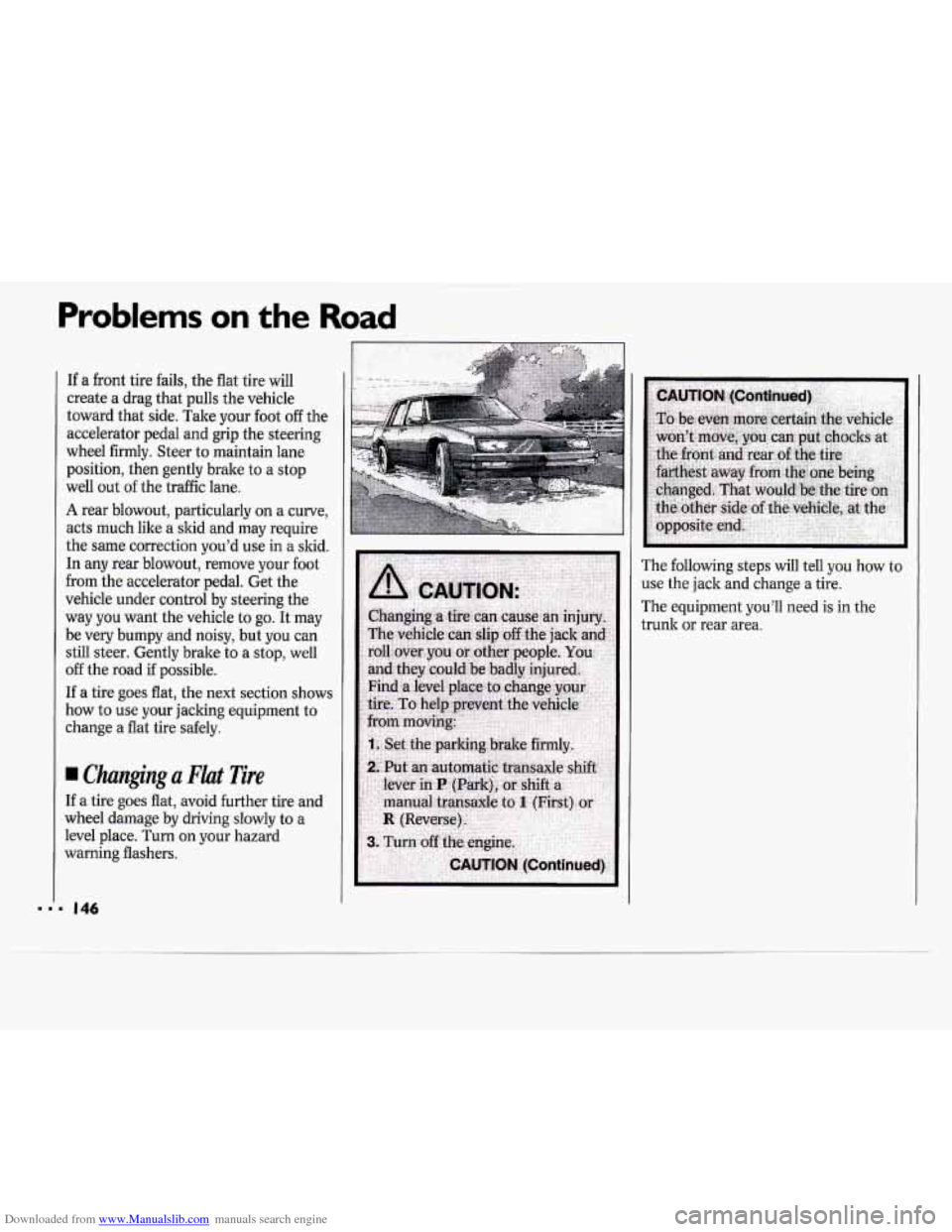
Downloaded from www.Manualslib.com manuals search engine Problems on the Road
If a front tire fails, the flat tire will
create a drag that pulls the vehicle
toward that side. Take your foot off the
accelerator pedal and grip the steering
wheel firmly. Steer to maintain lane
position, then gently brake to
a stop
well out
of the traffic lane.
A rear blowout, particularly on a curve,
acts much like a skid and may require
the same correction you’d use in a skid.
In any rear blowout, remove your foot
from the accelerator pedal. Get the
vehicle under control by steering the
way
you want the vehicle to go. It may
be very bumpy and noisy, but you can
still steer. Gently brake to a stop, well
off the road if possible.
If a tire goes flat, the next section shows
how to use your jacking equipment to
change a flat tire safely.
Changing a Flat Tire
If a tire goes flat, avoid further tire and
wheel damage by driving slowly to a
level place. Turn on your hazard
warning flashers. The
following steps will tell you how to
use the jack and change a tire.
The equipment you’ll need
is in the
trunk
or rear area.
Page 148 of 243
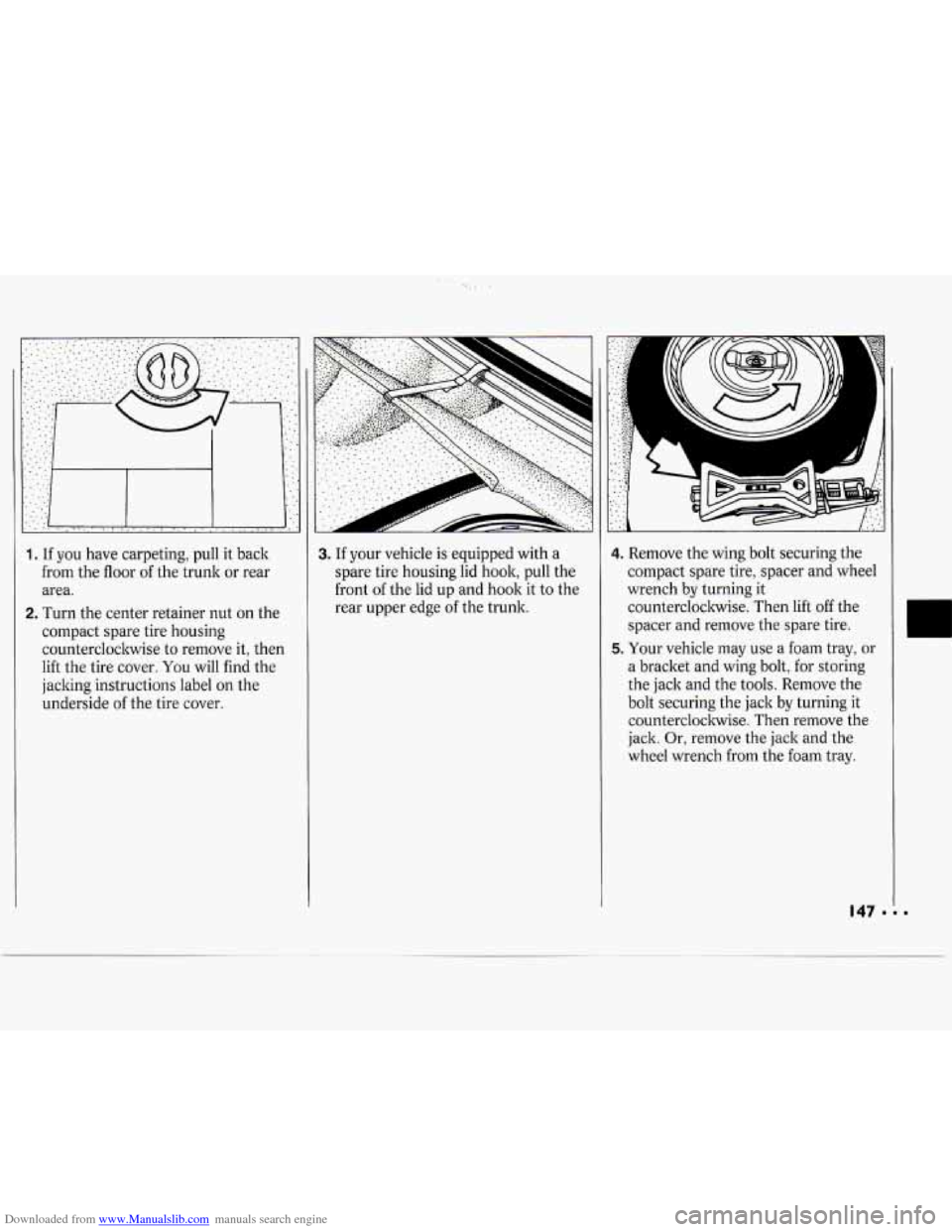
Downloaded from www.Manualslib.com manuals search engine 1. If you have carpeting, pull it back
from the floor of the trunk or rear
area.
2. Turn the center retainer nut on the
compact spare tire housing counterclockwise to remove it, then
lift the tire cover.
You will find the
jacking instructions label
on the
underside
of the tire cover.
..
3. If your vehicle is equipped with a
spare tire housing lid hook, pull the
front
of the lid up and hook it to the
rear upper edge
of the trunk.
4. Remove the wing bolt securing the
compact spare tire, spacer and wheel
wrench by turning it
counterclockwise. Then lift off the
spacer and remove the spare tire.
5. Your vehicle may use a foam tray, or
a bracket and wing bolt, for storing
the jack and the tools. Remove the
bolt securing the jack by turning it
counterclockwise. Then remove the
jack. Or, remove the jack and the
wheel wrench from the foam tray.
I
Page 149 of 243
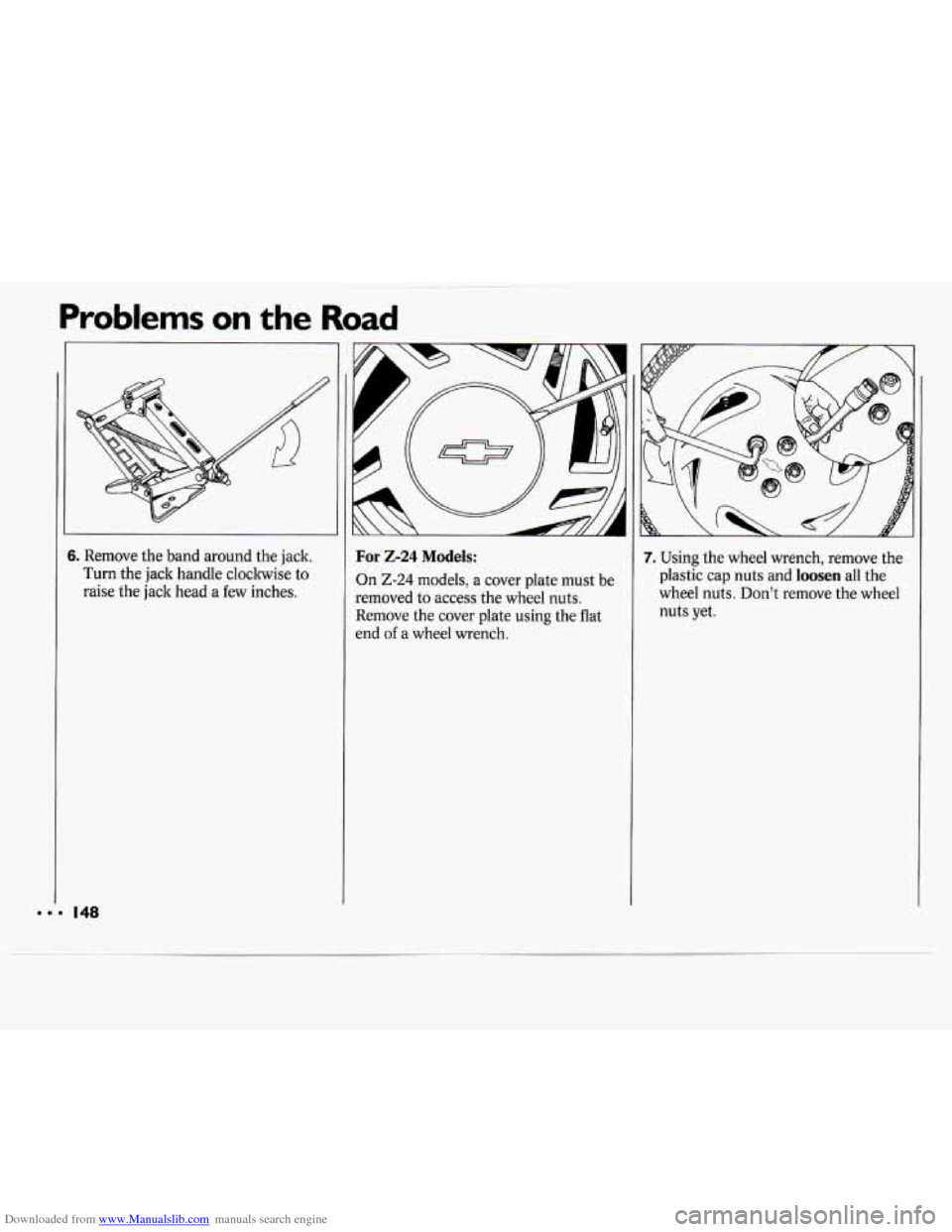
Downloaded from www.Manualslib.com manuals search engine Problems on the Road
5. Remove the band around the jack.
Turn the jack handle cloclnvise to
raise the jack head a few inches. For 2-24 Models:
On 2-24 models, a cover plate must be
removed to access the wheel nuts.
Remove the cover plate using the flat
end
of a wheel wrench.
7. Using the wheel wrench, remove the
plastic cap nuts and
loosen all the
wheel nuts.
Don’t remove the wheel
nuts yet.
Page 150 of 243
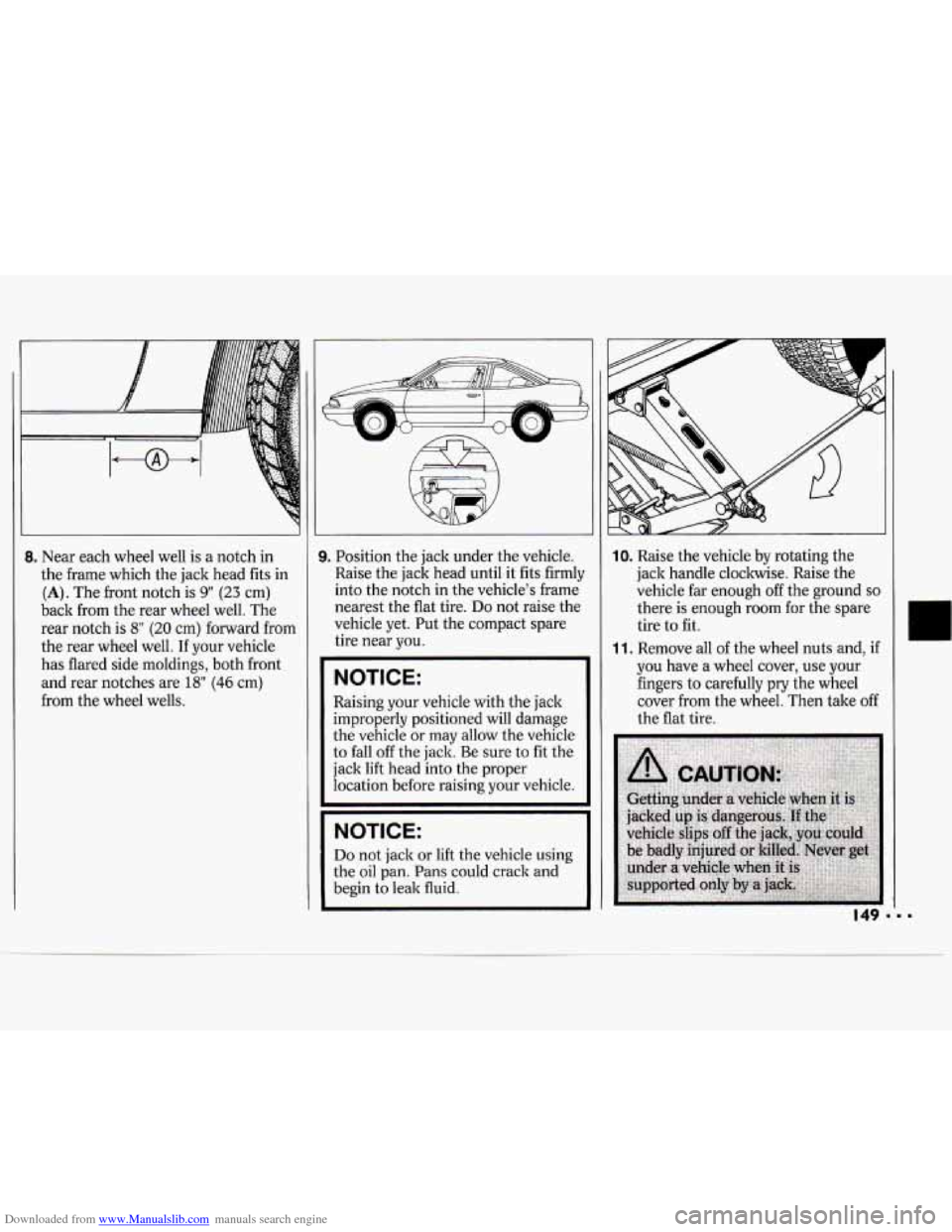
Downloaded from www.Manualslib.com manuals search engine 8. Near each wheel well is a notch in
the frame which the jack head fits in
(A). The front notch is 9" (23 cm)
back from the rear wheel well. The
rear notch is
8" (20 cm) forward from
the rear wheel well.
If your vehicle
has flared side moldings, both front
and rear notches are
18" (46 cm)
from the wheel wells.
I
~~ ~ ~~
9. Position the jack under the vehicle.
Raise the jack head until
it fits firmly
into the notch in the vehicle's frame
nearest the flat tire.
Do not raise the
vehicle yet. Put the compact spare
tire near you.
NOTICE:
Raising your vehicle with the jack
improperly positioned will damage
the vehicle or may allow the vehicle
to fall off the jack. Be sure to fit the
jack lift head into the proper
location before raising your vehicle.
NOTICE:
Do not jack or lift the vehicle using
the oil pan. Pans could crack and
begin to leak fluid.
10. Raise the vehicle by rotating the
jack handle cloclnvise. Raise the
vehicle far enough off the ground
so
there is enough room for the spare
tire to fit.
11. Remove all of the wheel nuts and, if
you have a wheel cover, use your
fingers to carefully pry the wheel
cover from the wheel. Then take off
the flat tire.
149 I